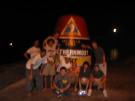 Cuban Influences in the United States
Cuban Influences in the United States
 Cuban Influences in the United States
Cuban Influences in the United States
From Miami and Beyond
Considered a diverse population, Cuban exiles have become an integral part of American society, one that has come to represent a unified whole. Due to the proximity of the city of Miami to that of the shores of Cuba, nearly half of all Cuban emigrants have settled in that area (44)and thus enriched its culture, bringing "Latin flavor to American shores" (45). There is even a part of downtown Miami named “Little Havaña” due to the large number of Cuban exiles and Cuban-American citizens. The Latin culture is alive and well in Miami and in other cities such as New York City and Houston partly because of the Cuban migration. One can easily go salsa dancing on a Friday night, or find an excellent recipe for flan by knocking on a neighbor's door. In areas such as “Little Havaña” it is even safe to say that you will be out of luck if you do not speak fluent Spanish. In total there were more than 1,000,000 Cubans who had immigrated to the United States by 1990 and the number continues to increase (46).
With each wave, differing aspects of Cuban culture were brought into the United States. Originally, the first wave brought with them their strong Catholic beliefs to influence the religion in highly Cuban areas (47). Many of these men and women were highly skilled professionals who quickly became doctors, lawyers and entrepreneurs. In fact, many mothers who had never held a working position while living in Cuba deemed it necessary to find a job when they came to the United States (48). As a greater diversity of Cubans came to the United States, the services that Cubans provided to themselves and native born Americans became more diverse. The waves continued to see men and women who were not as skilled, but their services were used to bolster the American economic system. Thus, poverty among Cuban immigrants seems to follow the pattern of the waves of migration. With each successive wave, there are fewer opportunities to improve the life condition, so therefore there is often more poverty for newer immigrants. Unfortunately, all immigrants who chose exile "suffer the loss of property, status, memories, peers" (49) when living in United States cities.
Like many islands in the Caribbean, Cuba had always been a multiracial society, with a mixing of class and social backgrounds for all ethnicities (50). Therefore, in coming to the United States, Cubans, at least in Miami and New York City, have begun to reform the ideas of racism that had long been held by those that had lived in these large metropolitan areas. Although there had been de facto segregation on the island many years before Castro, the racial lines were more complex than those in the United States, leading to more varied, yet less harsh segregation.
There are still those who live in Cuba for which Cuban family members who reside in the United States send back precious goods. Even though many relatives who still live in Cuba are bitter that their relatives emigrated (51), they often rely on the services that are only available to them by their American family members. Because of the tight governmental restrictions that Castro and the communist government have put on Cuban citizens, many family members in the states, including Silvia Pedraza herself, must ship precious necessities, such as toilet paper and canned goods, because they are not available or far too expensive for the average Cuban citizen to afford. This is as a result of the American embargo, and the fact that Cuba does not have "one single dominant market"(52) that can improve the livelihood of those still residing in Cuba.
It is hard to predict what will become of Cuba in the next generation. Perhaps Cuba will forever remain a communist state, or perhaps the 90 miles distance will one day become traversable for both native Cubans and native born Americans alike! Cuban-Americans simply hope to be able to one day enjoy their homeland and be able to travel freely back and forth.